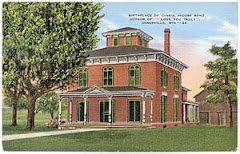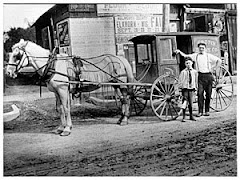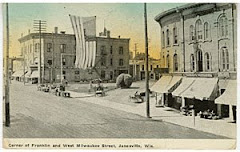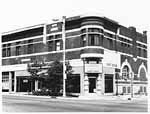
Thursday, July 16, 2009
Native Americans In Janesville

Blackhawk

Biography of Black Hawk
The man known to whites as Black Hawk was born Ma-ka-tai-me-she-kia-kiak (Black Sparrow Hawk) in the year 1767. Like most of the boys in his tribe, he learned to hunt and fish at an early age.
By the age of fifteen, Black Hawk had become a "brave." To become a "brave" he needed to kill or injure an enemy in battle. It was in later fighting with the Osage Indians that he earned the title of war chief. By the age of forty-five, he had killed thirty of this enemy's warriors.
Black Hawk was strong and independent minded. As a young man, he recognized the dangers of alcohol and decided never to drink the "fire water." He went against another Sauk custom of marrying more than one woman. Black Hawk married young and remained loyal to his wife, Asshewaqua (Singing Bird) throughout his life. Most successful warriors married several women.
In religion and war Black Hawk was a traditional Sauk. He rejected Christianity and continued to practice their ancient religion. Fighting was very important to the Sauk, and the warriors were ever-ready for battle. They relied on the Great Spirit to give them direction in war.
By the end of the 1700s, the Sauk were coming into contact with more and more white settlers and traders. The Sauk decided that for their own protection they would sign the Treaty of Greenville in 1795. It promised that the Sauk would be received with friendship and given protection by the United States.
In 1804, after a fight between whites and Sauk ended in the deaths of three settlers, some Sauk leaders agreed to travel to St. Louis and arrange a permanent peace. The Sauk leaders were given alcohol and asked to sign a treaty. The treaty gave the government fifteen million acres of Sauk land in Illinois, Wisconsin and Missouri for the sum of $2,274.50.
Black Hawk and other Sauk chiefs argued that the treaty was not valid because most of the Sauk Nation was not told of the treaty, and those who signed did not represent them. The government insisted the treaty was binding.
Tensions grew between the two sides until, in 1808, the Americans built a fort in the disputed territory. Black Hawk lead a war party to destroy the fort and massacre the troops but withdrew when confronted with loaded cannons.
Three years later the war of 1812 erupted between Great Britain and the United States. Black Hawk who had remained friendly to the English decided to fight on their side. Another broken promise by America strengthened his decision. The Americans said they would furnish the Sauk with supplies to help them survive. No supplies were ever sent by the government.
Saying " I have fought the Big Knives and will continue to fight them till they are off our lands," Black Hawk went on attacking the Americans even after the war with Britain was over. Finally a treaty was signed to bring about a temporary peace.
By 1821 lead mining brought floods of white settlers to northwestern Illinois and southwestern Wisconsin. By 1828 the Sauk and the Fox tribes were forced from their lands and driven across the Mississippi River. In the spring after a snub by President Andrew Jackson, Black Hawk decided to return across the river and reclaim his land.
The Winnebagos and other tribes in the area, fearing the militia, refused to let Black Hawk stay. Reluctantly, he decided to swallow his pride and return to Iowa.
Meanwhile, the militia was approaching. Black Hawk sent five warriors to tell the militia that his people wanted to peacefully retreat across the Mississippi. All of the warriors were immediately taken prisoner. Black Hawk sent more warriors to see what happened. They were attacked and two warriors were killed. The militia set out after the rest of Black Hawk's people. They were ambushed by Black Hawk and forty of his braves. Eleven of the militia and three of the warriors were killed before the militia broke and ran.
The war had begun. Winnebago and Potawatomi warriors joined Black Hawk and the raided villages and farms through northern Illinois and southern Wisconsin. At Ottawa, Illinois, they shot, tomahawked and mutilated the bodies of fifteen settlers and kidnapped two teen aged girls. ( The girls were later released ). These attacks created widespread panic among the white settlers and thousands fled the area.
Black Hawk was still trying to get across the Mississippi. He decided to travel through the Wisconsin wilderness. To cover his retreat he sent out war parties to attack white settlements hoping to delay the pursuing soldiers. As Blackhawk fled the Rock River Valley, he followed the Rock River and arrived at a spot near the Big Rock. Here he forded the river and made his way to the woods that we now know as Palmer Park. Here they camped and rested. The soldiers continued to pursue Blackhawk. (inserted into original article).
On July 21, 1832, the troops finally caught up with Black Hawk's rear guard near present-day Sauk City, Wisconsin. The ensuing battle ( The Battle of Wisconsin Heights ) cost the lives of five warriors and one soldier. The soldiers leery of an ambush let the Sauk slip away an escape.
Black Hawks only hope lay in out running the soldiers and he raced to the Mississippi. When he arrived at the river he found his way blocked by an American steamship loaded with troops and artillery. Black Hawk tried to surrender and sent two warriors under a white flag to the ship. The ship's captain did not understand the request and opened fire on the Sauk. Black Hawk and his followers were trapped.
The next day, August 2, 1832, the soldiers caught up with the Sauk. In what became known as the Bad Axe Massacre, the soldiers killed dozens of the Sauk including women, children and the elderly. Those who made it across the Mississippi were killed by the Sioux, who had joined the Americans. Of the 500 Sauk with Black Hawk, only about 150 survived. The Black Hawk war, now virtually over, had cost the lives of 72 whites and between 450 and 600 Native Americans.
Black Hawk was one of the survivors. He was eventually forced to surrender with his friend, White Cloud, of the Winnebago's. The were sent to the east and were paraded through the eastern cities like captured animals. The public , however, greeted him, "as a brave, romantic symbol of the wild frontier and treated him like a hero.
Black Hawk later was returned to Iowa. In the last few months of his life he found himself the object of admiration among Iowa settlers. He was often invited to the territorial capital to attend sessions of the legislature. His last public appearance was July 4, 1837.
Black Hawk died in his lodge on October 3, 1837. His wife Singing Bird survived him. In his last public appearance he said: " A few summers ago, I was fighting against you. I did wrong, perhaps, but that is past. It is buried. Let it be forgotten. Rock river was beautiful country. I loved my towns, my cornfields, and the home of my people. It is yours now. Keep it as we did."
Written by - Chuck Pitcel Cpitcel@madison.k12.wi.us

http://www.fordham.edu/halsall/mod/blackhawk.html
http://lincoln.lib.niu.edu/blackhawk/
http://www.suite101.com/content/the-black-hawk-war-a28568
http://www.google.com/search?q=chief+blackhawk&hl=en&prmd=ivns&tbs=tl:1&tbo=u&ei=37leTZCoL8P38AbVqsyVDA&sa=X&oi=timeline_result&ct=title&resnum=20&ved=0CGkQ5wIwEw
http://www.mce.k12tn.net/indians/famous/black_hawk.htm
Frances E. Willard
 Frances Elizabeth Caroline Willard was born in Churchville, New York, on September 28, 1839. When she was just two years old, her parents moved to Oberlin, Ohio. France had an older brother named Oliver and a younger sister named Mary.
Frances Elizabeth Caroline Willard was born in Churchville, New York, on September 28, 1839. When she was just two years old, her parents moved to Oberlin, Ohio. France had an older brother named Oliver and a younger sister named Mary.Mr. Willard became ill while they lived in Ohio, and the doctors suggested that outdoor life would help him to recover. The family moved to a farm near Janesville, Wisconsin when Frances was seven years old.
Mr. Willard was a great scholar. When the family moved to Wisconsin, he brought all of his books with him. Oliver grew tired of loading and reloading books when the wagons became stuck in the mud holes. His father always replied that they could do without almost anything but books.
Mr. Willard bought nearly 1000 acres of land along the banks of the Rock River. A house was built among three large oak trees and was called Forest Home by Frances. Mr. Willard later gave some land on which the first school was built. This was also the first real school that Frances and Mary attended. Before that the children had lessons in their home. Mrs. Willard taught them. When the school was built, Miss Burdick was hired to teach the Willard children. The original school is now located on the Rock County 4-H Fairgrounds.

Frances Willard became the founder of the Women's Christian Temperance Union, (WCTU.) She became famous for her efforts to improve family living. Frances Willard died on February 17, 1898. A book written by Clara Ingram Judson called Pioneer Girl tells of the early years of Frances Willard.
She is the first woman to be represented by a statue in Statuary Hall in the U. S. Capitol in Washington, D.C. The statue was donated by the state of Illnois.

Frances E. Willard National Statuary Hall Collection, Washington, D.C.
Corn Exchange

This triangular piece of land in the heart of Janesville was a busy spot in the early days. Wooden hitching posts with iron rings were found around the outside of this area. Here the farmers tied their horses and wagons waiting for buyers to come and buy their produce. They sold cordwood, hay, grain, freshly sheared wool, potatoes and more.
William Morrison Tallman


Carrie Jacobs Bond Janesville's Famous Composer

Carrie Jacobs Bond was born in Janesville on August 11, 1862, in a brick house that was located on the present corner of West Court Street and North Oakhill Avenue. A marker telling of her birth has been placed in Bond Park behind Sunnyside Shopping Center. At the time Carrie was born, the house belonging to her grandfather was in the country on a fifteen-acre farm. When the house was torn down in 1944, many people in Janesville asked for one of the bricks for a souvenir. Some school children helped to scratch the name "Bond" on the bricks. Some of these bricks were kept in third grade classrooms in Janesville.
Carrie loved music and learned to play the piano. Both of her parents were musicians. By the time she was six years old, Carrie could play by ear anything that she had heard only one time. She was invited to play the piano at the Myers' Theatre when she was only eight years old. When she was ten, Carrie began taking piano lessons from local music teachers. She became an accomplished musician.
During Carrie's first marriage she began writing songs. Her first marriage was unhappy and ended in divorce. She later married Dr. Frank Bond and they moved to Iron River, Michigan. He died seven years later. Carrie and her son returned to Janesville. Upon her return she wrote the song "I Love You Truly," which became a favorite wedding song. Click on this link to hear Jim Cullum Jazz Band playing. http://video.google.com/videoplay?docid=6776881513701707347
Since she and her son were so poor, Carrie decided to move to Chicago in order to make money. She continued to write, and finally a professional singer became interested in her songs. In a short time these songs had sold a million copies each, and famous people began singing these compositions.
For more information about Carrie, click on this link. http://parlorsongs.com/bios/cjbond/cjbond.php
There is a marker on the northeast corner of Milwaukee and Wisconsin Streets identifying the location where her house once stood.
http://www.npr.org/templates/story/story.php?storyId=112348069
http://www.youtube.com/watch?v=0CM8yKoiG7c
A song that we can sing with:
http://www.youtube.com/watch?v=x4H7tSIn8mk
Burr Robbins Circus Wintered in Janesville











